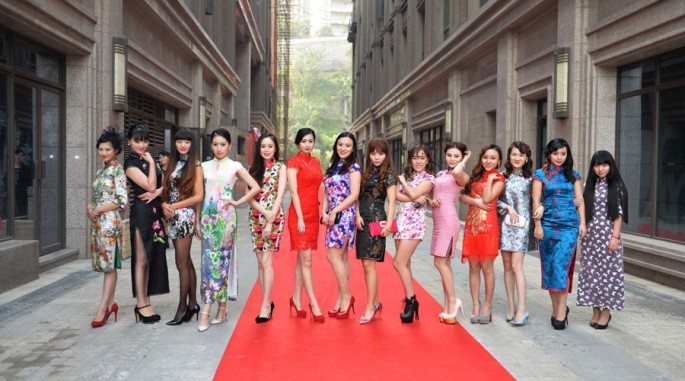A qipao, which was was once a heavy and shapeless robe Manchu ladies wore, is now popular again. A qipao is a modern figure-hugging dress Shanghai women considered a must on their wedding day. Six decades later, the dress still stands as an unspoken Chinese icon despite twists and turns.
China's first lady, Peng Liyuan, ignited public interest when she wore qipao-style dresses while accompanying her husband during state visits. The "Liyuan style," according to fashion experts, will spark interest in the traditional garment's rebirth.
"Few things portray a Chinese woman's beauty better than the qipao. A woman must be reserved and gentle to look perfect in the dress, and these traits are consistent with the Chinese identity," said Fashion and Art Design Institute of Donghua University retired professor Bao Mingxin.
Qipao flatters the Chinese female figure perfectly, Bao said. "It is demanding on the figure but women with slender curves wear it best. Those who are too big or too curvy may look funny in the dress."
The traditional garment is very different from Western-style clothes, according to Miss Etiquette at the Beijing 2008 Olympics's qipao designer Guo Pei. "Western dresses give shape to people of all dimensions, but the soft fabric of qipao only looks good on a certain figure," she said.

The qipao gained popularity in the 1920s. Believed to have emerged in the Qing Dynasty (1644-1911), the Manchu robe was seen as wide, flat, heavy and modestly hiding the woman's figure. But the qipao started its innovation and enjoyed its golden age in the 1930s as it took influence from Western cutting skills.
"Qipao made history in those years by demonstrating women's shape. After gaining popularity in Shanghai, led by young students, it became standard attire nationwide," said Bao.
Imported apparel fabric paved way for China's first fashion season. Movie stars were invited to qipao by fashion company Hongxiang, which consequently had six dresses shown at the Chicago World Expo in 1933.
Soong Ching-ling, wife to Dr. Sun Yat-sen, the founding father of the first Republic of China, exuded a classic look when she wore a cardigan with qipao. This triggered a mix-and-match fashion among female intellectuals.
However, the qipao was replaced by labor clothes during the "cultural revolution" (1966-1976), as people became more dedicated to work.
The 1980's showed success in the fashion design industry but designers and consumers interest has already shifted to jeans and boots. "Qipao, which was left out for three decades, seemed outdated," Bao said.
The 1990s finally opened the doors for the trend of wearing the qipao again, as people began to wear them in films, fashion shows and beauty contests more frequently.
Today, women, home and abroad, wear qipao for special and important events.
"I wore qipao at balls and banquets with students from all over the world because it's a widely recognized Chinese identity. I don't need to introduce myself and people will know I'm from China," said Wang Yijia, 26, who went to the United States in 2013 for a graduate study.
read more: mint green bridesmaid dresses
Comment
© 2024 Created by David Califa. Managed by Eyal Raviv.
Powered by
![]()
You need to be a member of iPeace.us to add comments!
Join iPeace.us